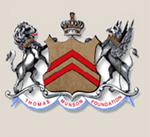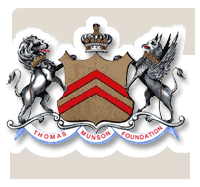Thomas¹ Munson (1612 – 1685)
The Thomas Munson Foundation is a not-for-profit family organization of the descendants of Thomas Munson (1612 – 1685) who established the family in the American colonies. The Foundation was incorporated in 1984 under the laws of the State of Michigan.
ENGLISH ANCESTRY
The ancestry of Captain Thomas¹ Munson (1612-1685) of New Haven Colony begins in England during the 14th century. According to Burke’s Peerage and Baronetage of the British Empire, John Monson was “living in 1378 and lived in East or Market-Rase, Lincoln County, England. John Monson had a male descendant, William¹ Monson, Esquire who lived in South Carlton, Lincolnshire, and who died in 1558. William¹ had two sons, John ² and Robert ² both of whom lived in South Carlton, Lincolnshire. More is known about Robert ². He studied at Cambridge University 1545-46, was an eminent lawyer, and died 24 September 1583 being buried in Lincoln Cathedral.
John ² Monson, of South Carlton had a son, John³ Monson. John³ was knighted, and attained the title Sir John³ Monson. He lived in a manor home in South Carlton, and died in 1593. Sir John ³ had two sons: Thomas⁴ Monson (1564 – 1641) and William⁴ Monson (1569 – 1643), both of South Carlton. Thomas⁴ attended Oxford University, was knighted in 1588, was appointed master-falconer and master of the armory at the Tower by King James I, and on 29 June 1611 was created First Baronet. William⁴ attended Oxford University at age 14, but quit university and set off to sea at age 16. He had a distinguished naval career (1588 – 1635) achieving the rank of Admiral of the Narrow Seas in 1604, and also being knighted along the way.
Sir Thomas⁴ Monson, knight and First Baronet of South Carlton is credibly presumed to be the father of the American pioneer-ancestor Captain Thomas¹ Munson (1612-1685) who ventured to America in 1637 to join the colonies in Hartford and settle in New Haven, and who originated the Munson family in “the New World.” If Thomas¹ Munson had stayed in Carlton, he would have been Second Baronet.
In Volume I of The Munson Record (1896) Introductory pages xxi – xxvii, author Myron Andrews⁹ Munson continues the English Monson ancestry through William-John¹² Monson (1829 – ) who was Seventh Baronet.
GENERATIONS 1 AND 2
The Munson ancestry in the United States starts with Thomas¹ Munson upon his arrival in the Hartford colony in 1637. Thomas¹ was born in 1612 and died 7 May 1685 at age 73. He married Joanna¹; maiden name is unknown. Joanna¹ was born in 1610 and died 13 December 1678 at age 68. Thomas¹ was a carpenter, served in the military rising to rank of Captain, and served in local government. During his life, he resided in Hartford (1637 – 1639) and New Haven (1639 – 1685).
Thomas¹ and Joanna¹ had three children:
- Elisabeth²: birthdate unknown; 3 marriages; 4 children; resided in New Haven, Elizabeth Town NJ, Stamford CT; died 18 December 1706
- Samuel²: born 7 August 1643; 1 marriage; 10 children; resided in New Haven, Wallingford; died sometime between 10 January and 2 March 1693
- Hannah²: born 11 June 1648; 2 marriages; 9 children; resided in New Haven; died 30 November 1695
ANNALS OF THOMAS¹, THE ORIGINATOR
In Volume I pages 1-60 of The Munson Record (published in 1896), author Myron Andrews⁹ Munson had written a comprehensive biography of Thomas¹ Munson’s life in America. The full text is available in three parts in the drop-down menu. Highlights are given below.
Where He Lived
Hartford (1637-1639)
Thomas¹ Munson came to America from England in 1637 at age 25. He became a resident of the colony in Hartford, and performed military service during the Pequot War. As a soldier, he was granted a house-lot of 2.5 acres on the east side of High Street, opposite the head of Walnut St. There was a house on this ground in February 1641, which was probably built by Thomas¹ , as he was a trained carpenter. He sold the lot and house to Nathaniel Kellogge most likely in 1639.
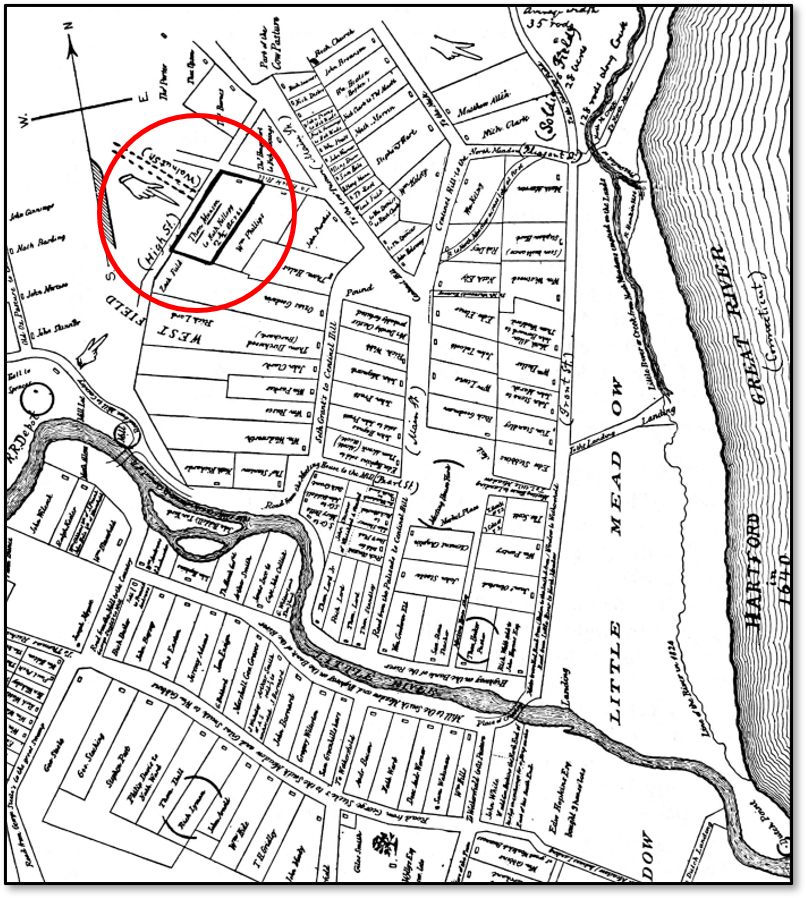
Soldier’s House-Lot Plats
Hartford 1640
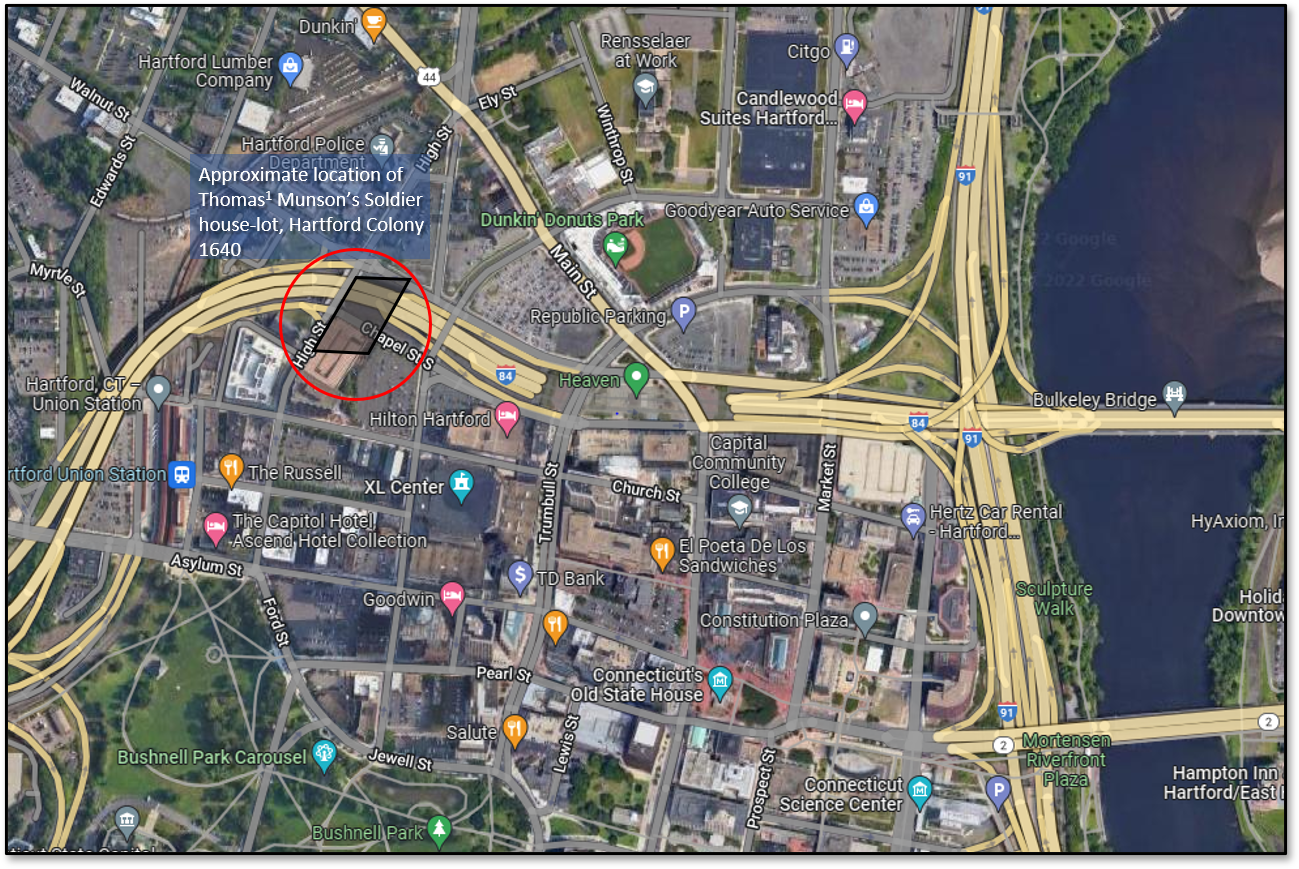
Google Map Image
Hartford, CT 2022
Quinnipiac (1639)
In 1639, Thomas¹ quit the Hartford plantation and cast in his lot with the settlers at Quinnipiac. The Historical Catalogue of the First Church of Hartford, gives the names of 147 early members, as early as 1639. Seventy four of them, including Thomas¹ Munson, are said to have moved on to other settlements outside of Hartford.
New Haven (1640-1685)
In April 1638, a fellow named Davenport, along with his companion adventurers, sailed into West Creek out of New Haven Harbor. During that Spring of 1638, Davenport mapped out a town-square north of West Creek measuring about 3000 feet x 3000 feet, and that consisted of nine equal squares, each measuring 1000 feet by 1000 feet, or almost 23 acres. The orientation of the square is rotated 29 degrees East of North. The following year, 1639, on June 4, a Fundamental Agreement was enacted in Robert Newman’s barn, that was located near the northern border of the North Central square. The main point of the Agreement was that church-members only should be free burgesses, and have the elective franchise. Sixty-three “free planters” assented to the “Agreement”, and their names were appended to the instrument by Thomas Fugill, secretary. It was ordered that whoever should hereafter “be admitted here as planters” should subscribe their names to the “Agreement.” Thomas¹ Munson is the sixth signatory in the list of forty-eight. This suggests that Thomas¹ migrated from Hartford through Quinnipiac to New Haven Colony in 1639.
No later than 1640, Thomas¹ and thirty-two other “planters” were freely granted small lots on the north bank of West Creek and south of the established New Haven town square of 1638. Thomas¹ ’s lot was between George Street and West Creek. He lived there for 11 years. In 1651, he sold his home, barn, shop, henhouse, and land. In 1652, he petitioned the Towne to grant him a residential lot. It did, and in return he was required to build a suitable house and to follow the Trade of making wheels and plows for the good of the Towne.
In 1654 Thomas¹ and John Cooper presented a petition on behalf a company of New Haven persons intending to relocate to Delaware Bay and establish a new commonwealth there for the purposes of “enlarging the Kingdom of Christ, spreading of the gospel, and providing prosperity therein.” For two years, Thomas¹ was in Delaware Bay leading the attempt to establish this new colony, but ultimately it failed because of hostilities with Dutch and English settlers, and with indigenous Indians.
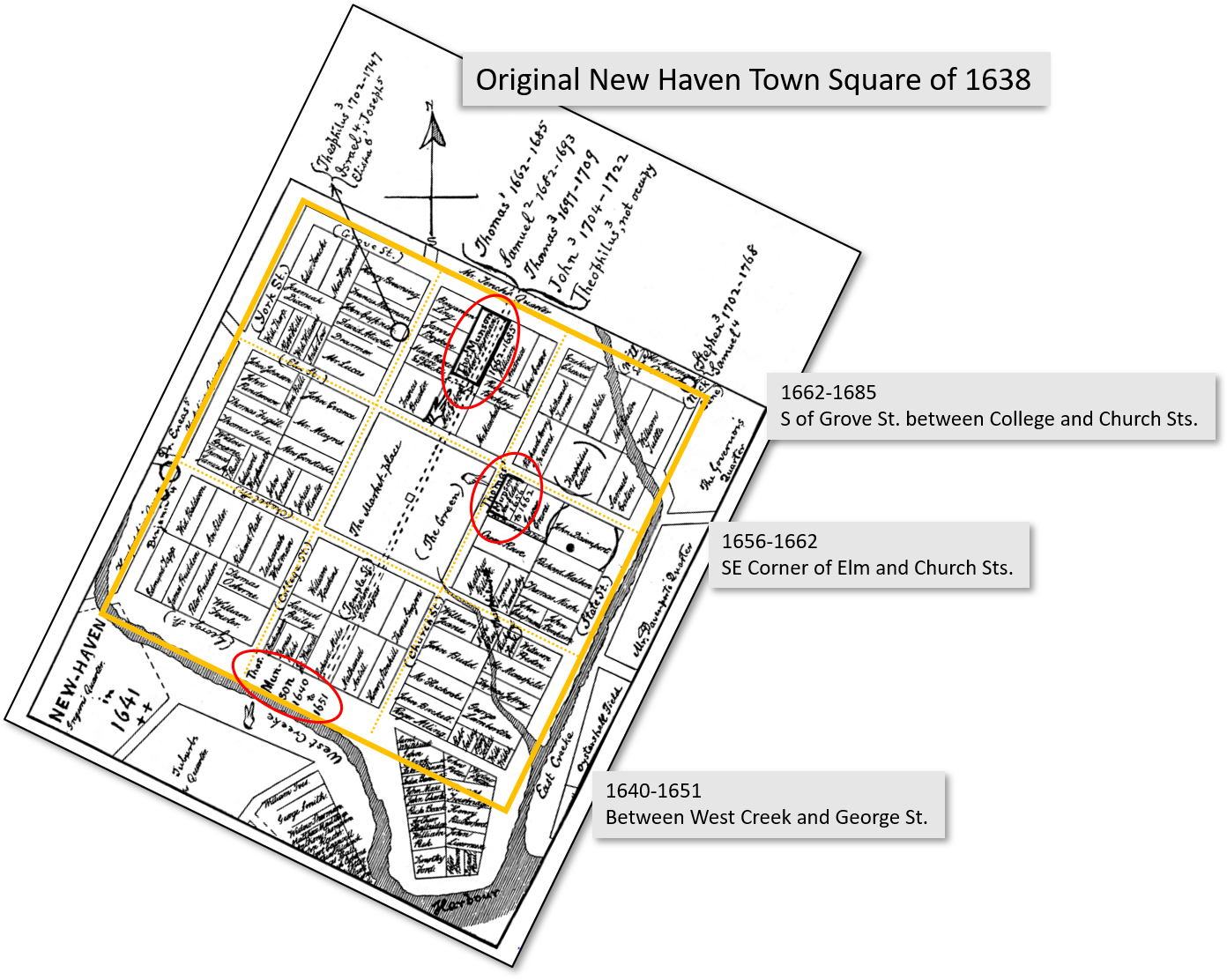
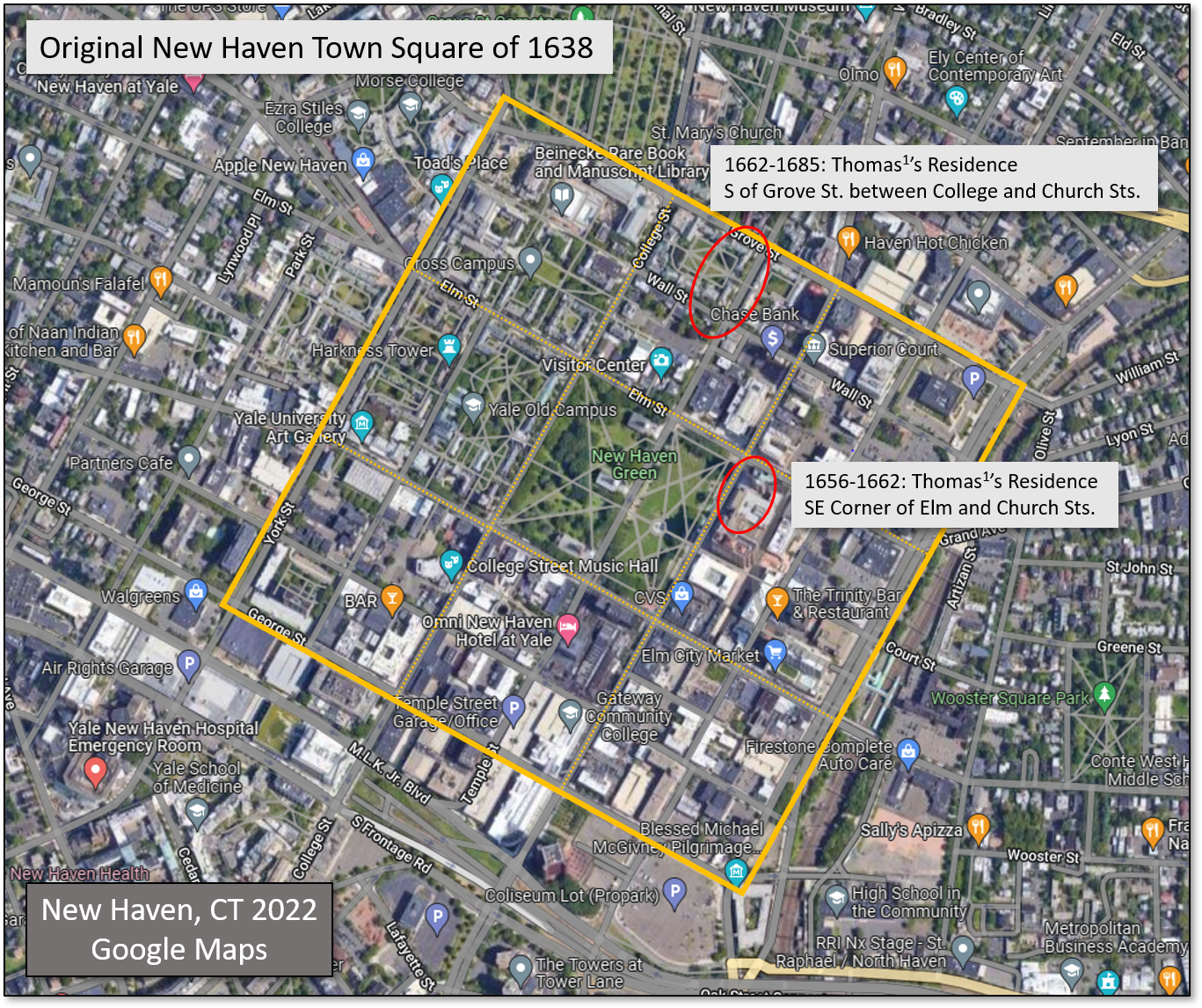
New Haven, CT 2022 with Original Towne-Square plat of 1638 and Residences of Thomas¹ Munson overlaid. Google Maps 2022
Retreating back to New Haven, Thomas¹ purchased in 1656 a “house-lot” of about 6 acres on the SE corner of Elm and Church Streets in the New Haven Town Square, and lived there six years.
In 1662, Thomas¹ purchased the Townes House property previously belonging to Mr. Kitchells. This was Elder Robert Newman’s place, and is now divided by Temple St, extending from Grove to Wall St. Interesting, the “mighty barn” that served as the signing place for the “Fundamental Agreement of 1639” was located on this property. Thomas¹ and his family resided in the home there until his death in 1685.
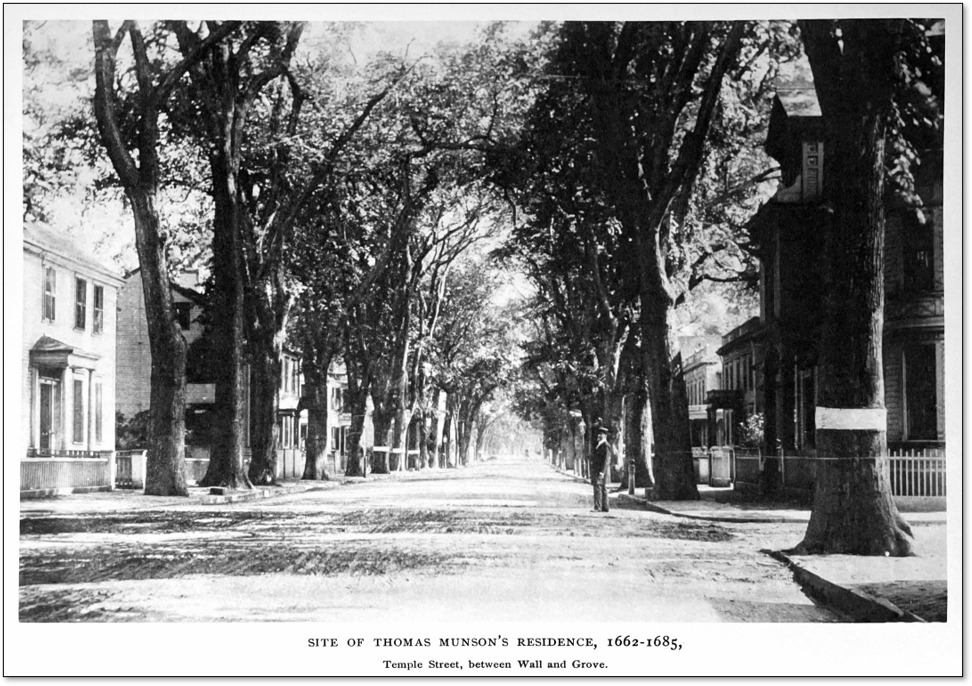
His Family
Thomas¹ Munson was born in 1612, Suffolk England, and was baptized in Rattlesden St. Nicholas Church, Suffolk that same year. He emigrated to America, and his presence is first documented in Hartford colony in 1637 at age 25. His wife’s name was Joanna¹ Munson. Her maiden name is unknown, and there is no record of their marriage date and location. Interestingly, Hotten’s Lists of Emigrants, page 279 (as recounted by Myron Andrews⁹ Munson in Volume I of The Munson Record), gives the names and ages of all the passengers who were on-board the sailing vessel Elizabeth of Ipswich, England, and that was bound for the New England colonies in April 1634. Among the passengers is a Susan Munson, age 25. This Susan, three years older than Thomas¹, may have been his wife. If this was the case, they were married in England and emigrated to America together, and further, it is unknown how or why, if she was Thomas¹’s wife, she became known as Joanna Munson.
Together, Thomas¹ and Joanna¹ had three children. The first child was Elisabeth² Munson. Her birth-date and birth-location are unknown. It is probable that she was born during Thomas¹’s time in Hartford (1637-1639) or during his migration from Hartford through Quinnipiac to New Haven arriving before summer of 1639. Her birth and baptism are not recorded in the First Church of New Haven as are those of her two younger siblings who were born in New Haven. Samuel² Munson was born August 7, 1643 and sister Hannah² Munson was born June 11, 1648. The births of Samuel² and Hannah² occurred when Thomas¹ and Joanna¹ were living on the “planters” lot between the north banks of the West Creek and George St, in the New Haven Colony.
The Munson Record Volume I author, Myron Andrews⁹ Munson writes in the Annals of Thomas¹ Munson mostly about Thomas¹’s endeavors. Not much is written about the activities of the women in Thomas¹’s life. Just the births, marriages, and deaths are accounted in the writings for Joanna¹, his wife, and Elisabeth ² and Hannah ², his daughters. Myron Andrews⁹ writes a lengthy biography on the life of son Samuel².
Elisabeth² Munson married Timothy Cooper of Springfield Colony on October 19, 1664, probably when she was in her early 20’s and most likely moved to the Springfield area, some 75 miles north from New Haven. Together, they had one son, John³ Cooper. His birth-date and birth location are unknown, and little is known of his life. Husband Timothy Cooper died sometime before September 30, 1679. Widow Elisabeth² moved back to New Haven and was a documented resident as of 1689. She married Richard Higinbothom of Stamford, and took up new residence there. Stamford is about 40 miles southwest from New Haven. The marriage date is unknown. Elisabeth² and Richard had three children: Rebekah³, born October 12, 1682 (note Elisabeth² would have been in her early 40’s at this time); Richard³ Jr, and Hannah³. Birth-dates for Richard³ Jr and Hannah³ are unknown. Both are documented to have married and had children in Stamford. Elizabeth² died December 18, 1706 in Stamford at age 66 or 67 years, but little is known about her life.
Samuel² Munson was born August 7, 1643 in New Haven while the family lived on the “planters” lot near the north banks of the West Creek, New Haven. He became a shoemaker and tanner by trade. He also participated in local government. He married Marth Bradley October 26, 1665 at age 22, and settled in New Haven. Together they had ten children: Martha³ born May 6, 1667; Samuel³ born February 28, 1669; Thomas³ born March 12, 1671; John³ born January 28, 1673; Theophilus³ born September 1, 1675; Joseph³ born November 1, 1677; Stephen³ born December 5, 1679; Caleb³ born November 19, 1682; Joshua³ born February 7, 1684; and Israel³ born March 6, 1686 (died June 18, 1697 at age 11). Samuel² died the winter of 1693 in New Haven at age 50.
Hannah² Munson was born June 11, 1648 in New Haven, also in the home on the “planters lot” near the north banks of West Creek, New Haven. She married Joseph Tuttle May 2, 1667 at age 18, and they settled in the area that today is East Haven, CT. Together they had nine children: Joseph³ born March 18, 1667; Samuel³ born July 15, 1670, Stephen³ born May 20, 1673; Johanna³ born December 30, 1675; Timothy³ born September 30, 1678 (died November 21, 1678); Susanna³ born February 20, 1680; Elisabeth³ born July 12, 1683; Hannah³ born May 14, 1685 (presumed died at birth); Hannah³ born February 26, 1686. Four years after the death of her husband Joseph Tuttle in September of 1690, she married Nathan Bradley of Guilford on August 21, 1694. They had no children together. Hannah² died November 30, 1695 at age 47.
Thomas¹ and Joanna¹ raised their young children at the “planter’s lot” on the north banks of West Creek until 1640. When Elisabeth² was about 12 years old, Samuel² 8 years and Hannah² 3 years, Thomas¹ and Joanna¹, left the planters lot and moved around a bit, until they settled into the home on the corner of Elm and Church Streets in the New Haven Town Square in 1656. By that time Elisabeth² was about 16 years old, Samuel² was 13, and Hannah² was 8. They resided at that home for six years. Then as their children grew older, Thomas¹ age 50 years and Joanna¹ age approximated at 53 years, moved to the home on Grove St between College and Church Streets in 1662 where they lived the rest of their lives. By the time they relocated to the Grove Street home, Elisabeth² was about 22 years old, Samuel² was 19 years old, and Hannah² was 14 years.
Within five years of moving into the Groves Street home, all three children were married and moved out: Elisabeth² in 1664 at about age 24 or 25 years; Samuel² in 1665 at age 21; and Hannah² in 1667 at age 18.
Elisabeth² relocated to Springfield, 75 miles north of New Haven, and little is known about her life and how much she visited New Haven with her family. However, Samuel² settled in New Haven and Hannah² moved to East Haven, less than five miles away. Both Samuel² and Hannah² began their families soon after marrying. Within the following 19 years (1667 – 1686), combined, they provided Thomas¹ and Joanna¹ with eighteen grandchildren. Joanna¹ died in December 1675, and only was able to enjoy 11 of these 18 grandchildren. Thomas¹ died in May 1685, the same month Hannah² most likely lost her baby Hannah³. Two more grandchildren were born in 1686, after Thomas¹’s death. It is unknown whether or not Thomas¹ knew any of Elisabeth²’s children, since she lived quite far away from New Haven. Certainly, Joanna¹ did not know any of Elisabeth²’s children with Richard Higinbothom since she died before Rebekah³ and her brothers were born.
Thomas¹ and Joanna¹ died before any 4th-generation descendant great-grandchildren were born and that are the ancestors for which the Thomas¹ Munson Clans are named. The first great-grandchild was Solomon⁴ Munson, born February 18, 1689 to Samuel³ of Wallingford (CT), 2nd child and 1st son of Samuel² of New Haven, only son of Thomas¹. In total, Thomas¹ and Joanna¹ had 3 2nd-generation children, 23 3rd-grandchildren (3 of whom died before adulthood), and 99 4th-generation great-grand children that are documented. There may be more because so little is known of Elisabeth²’s children and because only birthdates are known for Hannah²’s youngest two daughters. Amazingly, Samuel² had 75 documented 4th-generation grandchildren. To-date the 24 Munson clans are derived from a subset of Thomas¹ and Joanna¹’s 99 great-grandchildren.
His Military Career
Upon Thomas¹’s arrival in Hartford in 1637 at age 25, he was drafted as a Hartford soldier to fight in the Pequot War between the early English settlers and indigenous Indians. From that time in 1637 until 1642, Thomas¹ was known as Soldier Munson.
By 1639, he had relocated from Hartford to New Haven, and lived on a planter’s lot north of West Creek. In 1642, Thomas¹, age 30, was promoted to rank of Sargent, and remained as Sargent Munson for 19 years. In Spring of 1648, Sargent Thomas¹ and three other sergeants were called upon to perform rotating night watch including patrols and sentry duty in protection of the New Haven Colony. In 1649, the regional Governor called for Sargent Thomas¹ to travel to the Colony Court for the winter of 1649-1650 and provide protection. However, the New Haven Townsmen prevented the deployment, and required Sargent Thomas¹ to stay and help secure and defend New Haven Colony.
In 1654, commissioners representing Highness Oliver, the ruler of England, Scotland, and Ireland, came to the four English colonies in America for the purpose of uniting them to fend off hostilities from the Dutch Colonies that were established along the Hudson River and in New York. A quota of 133 men was requested from New Haven Colony, and Sargent Munson was one of the officers. Peace between England and the Dutch was made prior to the need of the New Haven regiment.
In 1661, Sargent Thomas¹, age 49, was promoted to rank of Ensign. This occurred just prior to moving to his home on Grove Street in 1662. In 1664, Ensign Munson, age 52, was promoted to rank of Lieutenant. In 1673, at age 61, Thomas¹ was appointed to the Grand Committee of New Haven Colony for the purposes of 1) establishing and commissioning military officers, and 2) securing transportation (horses, wagons) and material for the defense and safety of New Haven. Also that year, he was appointed as member of the New Haven Council of War that was established to defend against attacks from the Dutch colonies in New York.
King Philip’s War against the indigenous Indians of Connecticut and Massachusetts occurred in 1675. Lieutenant Thomas¹ received orders to command and lead New Haven troops north to Springfield and further north up the Connecticut River for the purposes of defending colonial plantations against attacks by indigenous Indians. One such attack was the burning of Springfield in the summer of 1675. This is the event attributed as the cause of death of Elisabeth²’s father-in-law Lieutenant Thomas Cooper, father of her husband Timothy.
In 1676, Lieutenant Munson, age 64, was promoted to his terminal rank of Captain with title: Captain of the New Haven County Soldiers. His command was to oversee fortifications, defense and security of New Haven Towne against attacks from Indians.
His Civic Service
Thomas¹ Munson came to America from England in 1637 at age 25. Nothing is mentioned by biographer Myron Andrews⁹ Munson about Thomas¹’s education in England. It is unknown whether or not he attended Oxford as did his father and uncle prior to setting sail for the New World. But it could be suspected, based on his Civic Service accomplishments in New Haven, that Thomas¹ was, at the very least, a somewhat educated man. It is documented that Thomas¹ was a religious man and was an active member of the New Haven Church for 45 years.
Official records of Thomas¹’s civic involvement begin in 1645, when he was asked to arbitrate various local disputes. One such dispute in 1645 was over the location and quality of fences between properties. It is surmised that before this and during the first five years (1640 -1645) that Thomas¹ and Joanna¹ lived on the Soldier’s lot on the North Banks of West Creek, they had their children, became members of the New Haven Church, and established themselves as respectable, trustworthy neighbors and citizens.
By trade, Thomas¹ was a carpenter, and during this time (1640-1645), he must have honed his skills and established his trade-craft reputation, because in 1646 he was asked to help make the decision where to locate a new bridge over the New Haven River, and in 1648 he was asked to inspect the pillars of the Meeting House (Church) for decay, and to recommend mitigations. This was a recurring responsibility related to New Haven infrastructure that was shouldered by Thomas¹. In 1656, he inspected and recommended repairs for the old, rotten West Bridge. In 1657, he inspected the Neck Bridge and recommended repairs. That same year, he headed a committee to evaluate how Beaver Pond Brooke could be redirected into town for the purposes of building a mill. He assisted with construction of the dam and mill. In 1665, he again inspected and advised on repairs to the Meeting House. In 1670, Thomas¹ proposed building a highway through the plains and swamps for timber harvest. The plan was approved in 1671. In 1677, Thomas¹ assisted with the planning and building of the highway from “ferry to farms at the iron works” which was the East Haven Thoroughfare. Also that year, he advocated and voted for (as an elected council townsmen) the building and staffing of the Hopkins grammar school for New Haven.
In the last 10 years of his life, Thomas¹ spent his days in New Haven working as an elected official to improve life in New Haven. For example, in 1678, he proposed a 1-penny/English pound tax on income to support new infrastructure projects such as the Hopkins grammar school, and East Haven Thoroughfare. In 1679 and as a General Court Senior Deputy, he was appointed to grant and register Deeds of Property. In 1680, he assisted with oversight and purchase-acquisition of the 3rd-Division land expansion of New Haven, and oversaw the sale and/or allotment of the parcels. In 1681, Thomas¹ became a member of the Court of Elections. Also that year, he moderated the town-wide debate concerning procurement of a bell for the New Haven Town Square. The town members voted “yes” for the bell, and it was purchased and installed in 1682.
By age 70, Thomas¹, through 42 years living in New Haven, must have earned the trust and respect of the citizens through either 1) his civic deeds, life experiences, fairness, religious practice, and wisdom, or 2) his military commands and actions, because he was chosen by the New Haven General Court to be the Town Constable and the Tax Collector in 1682. Thomas¹ refused these roles, and was excused from undertaking them.
Instead of completing his civic service in the undesirable roles of constable and tax collector, Thomas¹ finished his last year (1684) in New Haven government as an elected Townsmen and Deputy to the General Court, as he had since 1656.
Biographer, Myron Andrews⁹ Munson, completes his narrative of the Annals of Thomas¹ Munson (Volume I of The Munson Record) by characterizing him as “an able, useful and eminent citizen (of New Haven Colony) that departed this life May 7th, 1685…”
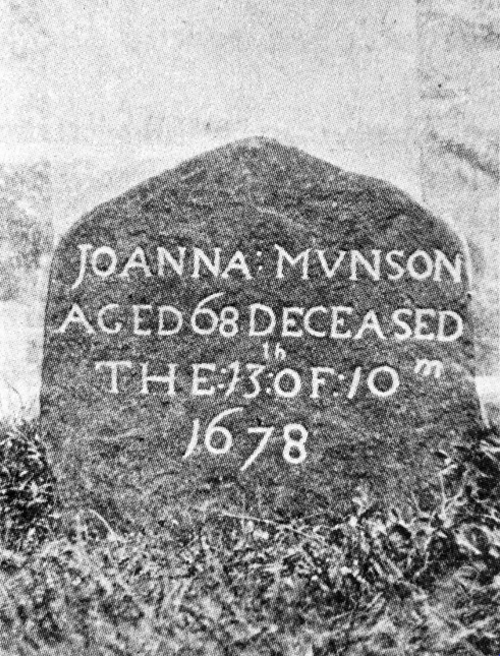
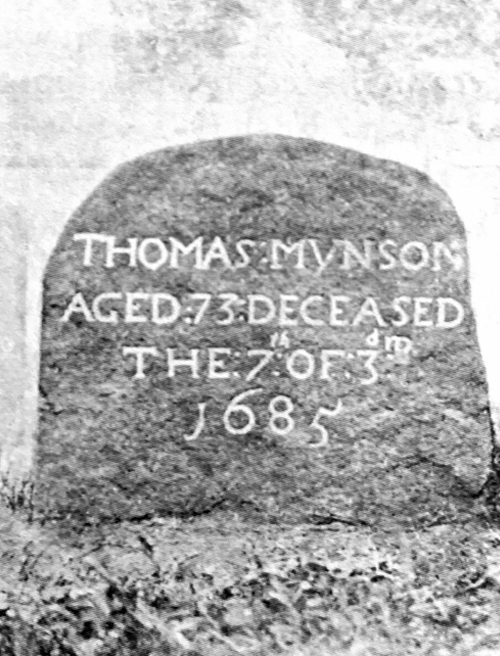
CONTEMPORARY EVENTS
In Volume I of the Munson Record, author Myron Andrews⁹ Munson compiles at the end of the section “Annals of Thomas¹, the Originator” a list of “Contemporary Events” that occurred during the life of Thomas¹ Munson.
| Age | Events |
| 4 yrs | Shakespeare died |
| 5 yrs | Lord Bacon became chancellor of England |
| 6 yrs | Sir Walter Raleigh beheaded; Thirty Years War (between Romish and Protestant princes of Germany) began |
| 7 yrs | Lord Bacon became chancellor of England |
| 8 yrs | The Pilgrims landed from the Mayflower upon Plymouth Rock |
| 11 yrs | The settlement of Manhattan Island, now New York City, began |
| 13 yrs | Charles I became king of England |
| 18 yrs | The settlement of Boston commenced |
| 20 yrs | Gustavus Adolphus of Sweden defeated Wallenstein and was killed at Lutzen |
| 23 yrs | Harford began existence |
| 25 yrs | The Pequot War occurred |
| 26 yrs | The settlers of New Haven spent their first Sabbath on 15 April 1638 worshipping under an oak tree which stood at the NE corner of George and College Streets; Harvard College was founded |
| 27 yrs | The New Haven Colony adopted a constitution which Thomas signed |
| 28 yrs | The Flemish painter Rubens died |
| 30 yrs | The Italian philosopher Galileo died |
| 31 yrs | Louis XIV succeeded his father as king of France |
| 34 yrs | The Apostle Eliot began his labors among the Indians |
| 37 yrs | Charles I was beheaded |
| 41 yrs | Cromwell became Lord Protector of England |
| 45 yrs | The Half-way Covenant appeared in New England churches |
| 48 yrs | Charles II crowned |
| 49 yrs | Whalley and Goffe arrived in New Haven |
| 50 yrs | New Haven Colony refused to be united by royal charter with Connecticut Colony |
| 53 yrs | New Haven Colony was united with the Connecticut Colony |
| 55 yrs | Sir Isaac Newton conceived the theory of gravitation; Jeremy Taylor died |
| 63 yrs | King Philip’s War broke out |
| 64 yrs | Milton and the Dutch painter Rembrandt died |
| 73 yrs | The Spanish painter Murillo died; James II was crowned |
